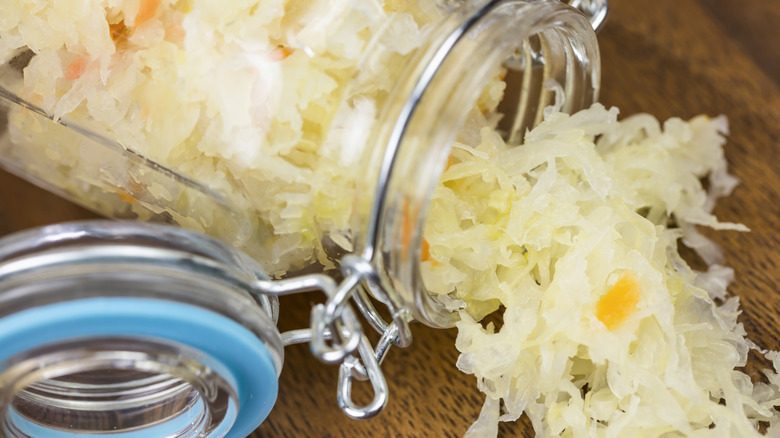The Long And Winding History Of Sauerkraut
Sauerkraut — which translates to "sour cabbage" in German – is exactly what it sounds like. It's just chopped cabbage that has been fermented to achieve a tangy and sour taste akin to things like pickles. Today, jars of sauerkraut line grocery store shelves, and it's a common condiment that can be found on top of bratwursts or spread on Reuben sandwiches worldwide. Sauerkraut is most often associated with German cuisine, but it actually has a long history that predates its European debut by about 2,000 years and more than 4,000 miles.
The first known versions of sauerkraut came from China as far back as 220 B.C.E., where it was a staple food amongst people tasked with building the Great Wall of China. Sauerkraut provided a food source that was high in vitamin C and gut-healthy probiotics and had a long shelf life thanks to letting it ferment in rice wine (sauerkraut today can stay fresh in the fridge for up to six months). While Germany's version of sauerkraut has its roots in China, it's also believed that ancient Romans independently created their own sauerkraut recipes too. Romans would soak whole cabbages in vinegar and salt, as they knew the finished product helped to alleviate digestion problems (thanks to the probiotics). So if sauerkraut originated in Eastern Asia and the Mediterranean, how on earth did it end up as an iconic staple of German cuisine?
Sauerkraut's journey to becoming a European staple
In the early 1200s, Genghis Khan's Mongolian armies invaded China. It's believed that they discovered China's sauerkraut invention during this conquest and started making it themselves. When they set their sights west and invaded parts of eastern and northern Europe, they brought sauerkraut with them, and Europeans became privy to its many benefits. Farmers learned that the fermentation process could preserve their cabbages throughout the harsh winters. Instead of using Chinese rice wine, they realized they could achieve the same effect by just letting the cabbage ferment in saltwater, and that's how the modern version of sauerkraut evolved.
Eventually, sailors learned that they too could use sauerkraut to their advantage. Just like the ancient workers on the Great Wall of China, sailors needed nutritious and long-lasting food to take with them on their voyages. It's estimated that scurvy, which is a disease caused by a severe lack of vitamin C, killed more than 2 million sailors just between the 16th and 18th centuries. Eventually, the British Royal Navy discovered that fresh citrus fruits warded off scurvy, and it was even mandated that each sailor had to consume three-quarters of an ounce of lemon juice per day, per the U.S. Naval Institute.
However, acquiring such large quantities of lemons was both expensive and impractical. British Captain James Cook took note of how Dutch ships seemed to have far fewer cases of scurvy and learned that they traveled with large amounts of sauerkraut to eat. He experimented with feeding sauerkraut to his crew and is often credited with finding the cure to scurvy aboard ships. While other versions of fermented cabbage, such as Korean kimchi, have exploded in popularity, sauerkraut is an ancient comfort food that brings a tangy brightness to a cozy plate of meat and potatoes.

